Effective Notch-Stress-Based Stress Concentration Factors of the Rib–Deck Weld in Orthotropic Steel Decks Considering the Effect of Asphalt Surfacing
Abstract
:1. Introduction
2. Review of Equations for Predicting the SCF
3. Finite Element Model for Parametric Analysis
4. Modified Formulae for Predicting the SCFs
4.1. Effect of the Transverse Loading Position
4.2. Combined Effect of the Transverse Loading Position and Asphalt Surfacing
4.3. Effect of the Temperature of Asphalt Surfacing
4.4. Validation of the Proposed Formulae
5. Conclusions
- (1)
- ENS-based SCFs of rib–deck welds are sensitive to transverse loading positions, and the greatest value corresponds to the loading position of x = −0.1 m. The ENS-based SCF increases when considering the combined effect of the asphalt surfacing, while the variation trend remains unchanged.
- (2)
- ENS-based SCFs are considerably affected by the temperature of asphalt surfacing. The lower the temperature is, the greater the ENS-based SCF is. And the ENS-based SCF decreases with an increase in temperature.
- (3)
- Based on the numerical results of ENS-based SCFs, predictive formulae are proposed to determine the ENS-based SCFs corresponding to arbitrary weld geometry, transverse loading position, and the temperature of the asphalt surfacing. Validation research shows that the proposed formulae could provide reliable results with a relative error within 10% (namely 5.14%, 7.34%, 8.36%, −1.27%, and −8.48% for the five cases, respectively), which is believed to be acceptable for real-world engineering applications.
Author Contributions
Funding
Institutional Review Board Statement
Informed Consent Statement
Data Availability Statement
Conflicts of Interest
References
- Tsakopoulos, P.A.; Fisher, J.W. Full-scale fatigue tests of steel orthotropic decks for the Williamsburg bridge. J. Bridge Eng. 2003, 8, 323–333. [Google Scholar] [CrossRef]
- Wang, Q.D.; Ji, B.H.; Fu, Z.Q.; Yao, Y. Effective notch stress approach-based fatigue evaluation of rib-to-deck welds including pavement surfacing effects. Int. J. Steel Struct. 2020, 20, 272–286. [Google Scholar] [CrossRef]
- Fisher, J.W.; Barsom, J.M. Evaluation of Cracking in the Rib-to-Deck Welds of the Bronx–Whitestone Bridge. J. Bridge Eng. 2016, 21, 04015065. [Google Scholar] [CrossRef]
- Xue, J.W.; Wang, J.Q.; Yi, J.Y.; Wei, Y.; Huang, K.J.; Ge, D.M.; Sun, R.Y. Optimal parking path planning and parking space selection based on the entropy power method and Bayesian network: A case study in an indoor parking lot. Sustainability 2023, 15, 8450. [Google Scholar] [CrossRef]
- Wang, J.Q.; Li, Q.; Huang, K.J.; Ge, D.M.; Gong, F.Y. Sustainable recycling techniques of pavement materials. Materials 2022, 15, 8710. [Google Scholar] [CrossRef] [PubMed]
- Su, P.F.; Li, M.M.; Dai, Q.L.; Wang, J.Q. Mechanical and durability performance of concrete with recycled tire steel fibers. Constr. Build. Mater. 2023, 394, 132287. [Google Scholar] [CrossRef]
- Hobbacher, A. Recommendations for Fatigue Design of Welded Joints and Components; Springer International Publishing: Berlin, Germany, 2016. [Google Scholar]
- Esderts, A.; Willen, J.; Kassner, M. Fatigue strength analysis of welded joints in closed steel sections in rail vehicles. Int. J. Fatigue 2012, 34, 112–121. [Google Scholar] [CrossRef]
- Duan, M.J.; Wang, F.; Wu, Y.T.; Tao, H.; Zhang, D.P. Sensitivity analysis of structural parameters of unequal-span continuous rigid frame bridge with corrugated steel webs. Appl. Sci. 2023, 13, 10024. [Google Scholar] [CrossRef]
- Duan, M.J.; Zhu, J.T.; Gu, Z.; Fang, Z.J.; Xu, J.Y. Analysis of the temperature field effect on the thermal stress of the main tower of long-span suspension bridges. Appl. Sci. 2023, 13, 8787. [Google Scholar] [CrossRef]
- Lotsberg, I.; Sigurdsson, G. Hot spot stress S-N curve for fatigue analysis of plated structures. J. Offshore Mech. Arct. Eng. Trans. ASME 2006, 128, 330–336. [Google Scholar] [CrossRef]
- Radaj, D.; Lehrke, H.P.; Greuling, S. Theoretical fatigue-effective notch stresses at spot welds. Fatigue Fract. Eng. Mater. Struct. 2001, 24, 293–308. [Google Scholar] [CrossRef]
- Pachoud, A.J.; Manso, P.A.; Schleiss, A.J. New parametric equations to estimate notch stress concentration factors at butt welded joints modeling the weld profile with splines. Eng. Fail. Anal. 2017, 72, 11–24. [Google Scholar] [CrossRef]
- Luo, Y.X.; Tsutsumi, S.; Han, R.; Ma, R.L.; Dai, K.S. Parametric formulas for stress concentration factor and clamping-induced stress of butt-welded joints under fatigue test condition. Weld. World 2022, 66, 1897–1913. [Google Scholar] [CrossRef]
- Yung, J.L.; Lawrence, F.V. Analytical and graphical aids for the fatigue design of weldments. Fatigue Fract. Eng. Mater. Struct. 1985, 8, 223–241. [Google Scholar] [CrossRef]
- Terán, G.; Albiter, A.; Cuamatzi-Meléndez, R. Parametric evaluation of the stress concentration factors in T-butt welded connections. Eng. Struct. 2013, 56, 1484–1495. [Google Scholar] [CrossRef]
- Brennan, F.P.; Peleties, P.; Hellier, A.K. Predicting weld toe stress concentration factors for T and skewed T-joint plate connections. Int. J. Fatigue 2000, 22, 573–584. [Google Scholar] [CrossRef]
- Oswald, M.; Mayr, C.; Rother, K. Determination of notch factors for welded cruciform joints based on numerical analysis and metamodeling. Weld. World 2019, 63, 1339–1354. [Google Scholar] [CrossRef]
- Wang, B.X.; Zhao, W.G.; Du, Y.L.; Zhang, G.Y.; Yang, Y. Prediction of fatigue stress concentration factor using extreme learning machine. Comput. Mater. Sci. 2016, 125, 136–145. [Google Scholar] [CrossRef]
- Wang, Q.D.; Ji, B.H.; Fu, Z.Q.; Yao, Y. Parametric equations for notch stress concentration factors of rib-deck welds under bending loading. Front. Struct. Civ. Eng. 2021, 15, 595–608. [Google Scholar] [CrossRef]
- Wang, Q.D.; Fu, Z.Q.; Wei, Y.; Wang, Y.X.; Yao, Y. Predicting the ENS-based SCFs of rib-deck welds by integrating HSS measurement. J. Constr. Steel Res. 2023, 203, 107828. [Google Scholar]
- JTG D64-2015; Specifications for Design of Highway Steel Bridges. China Communications Press: Beijing, China, 2015.
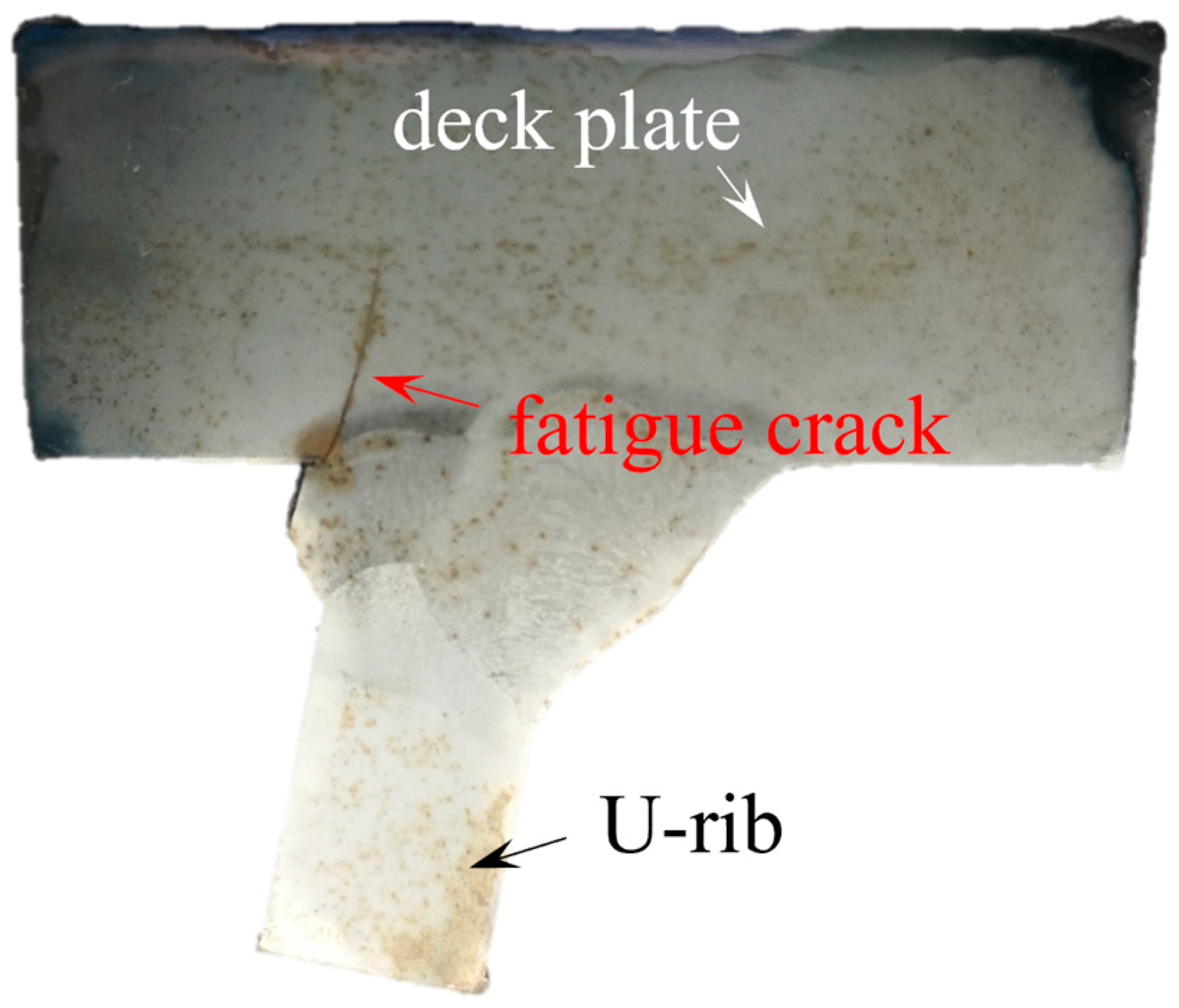


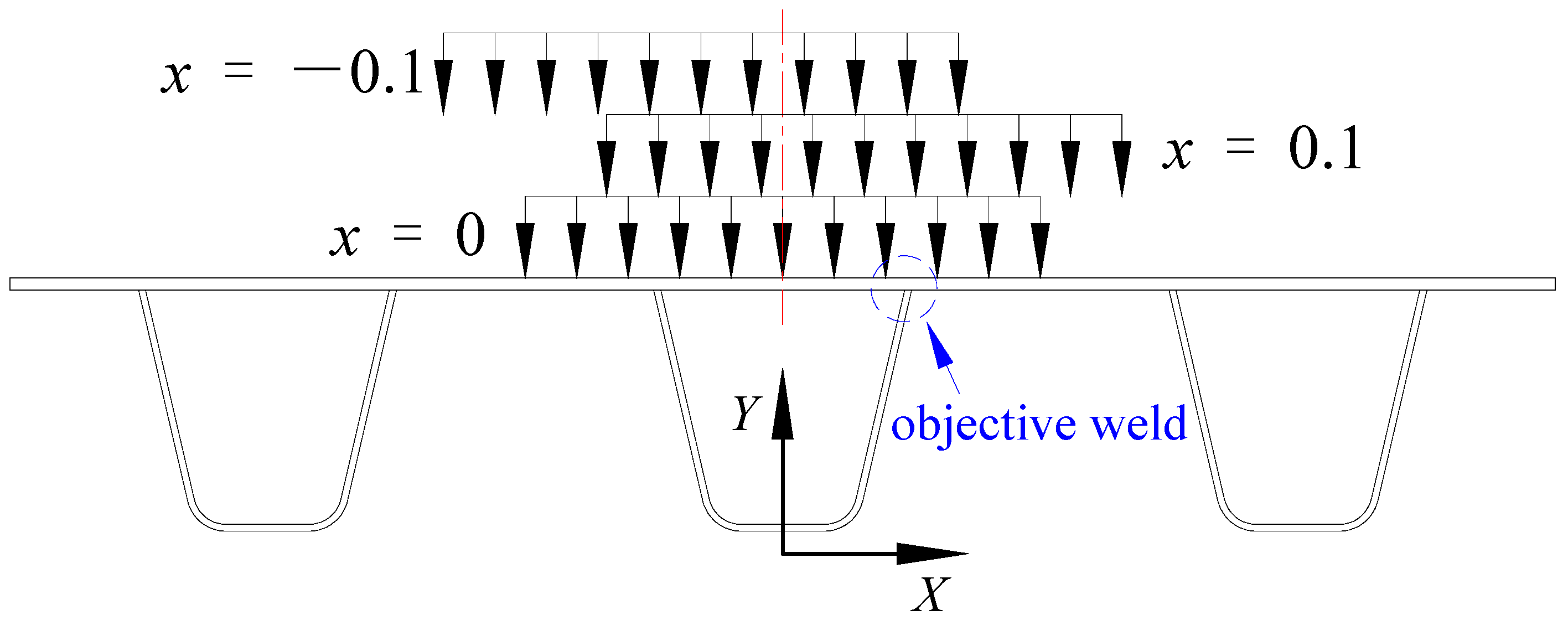
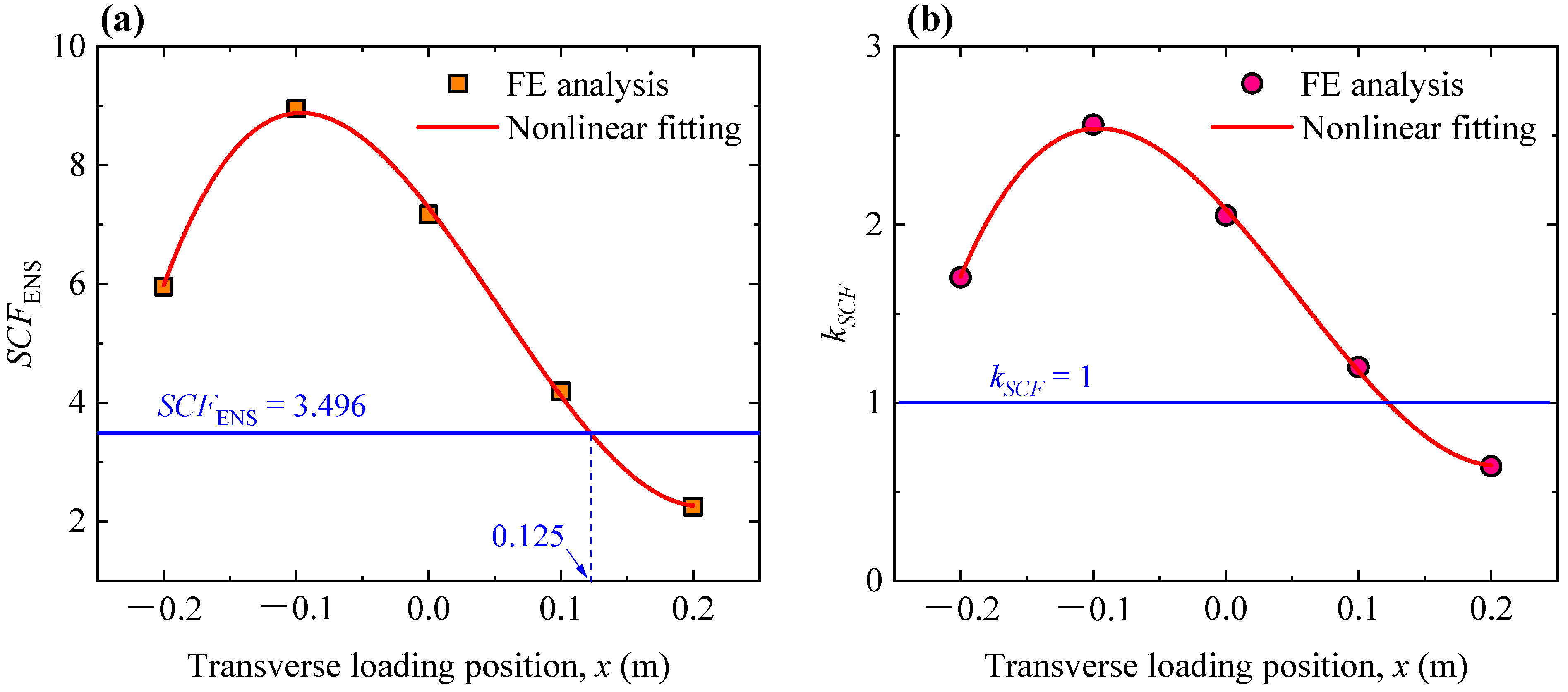

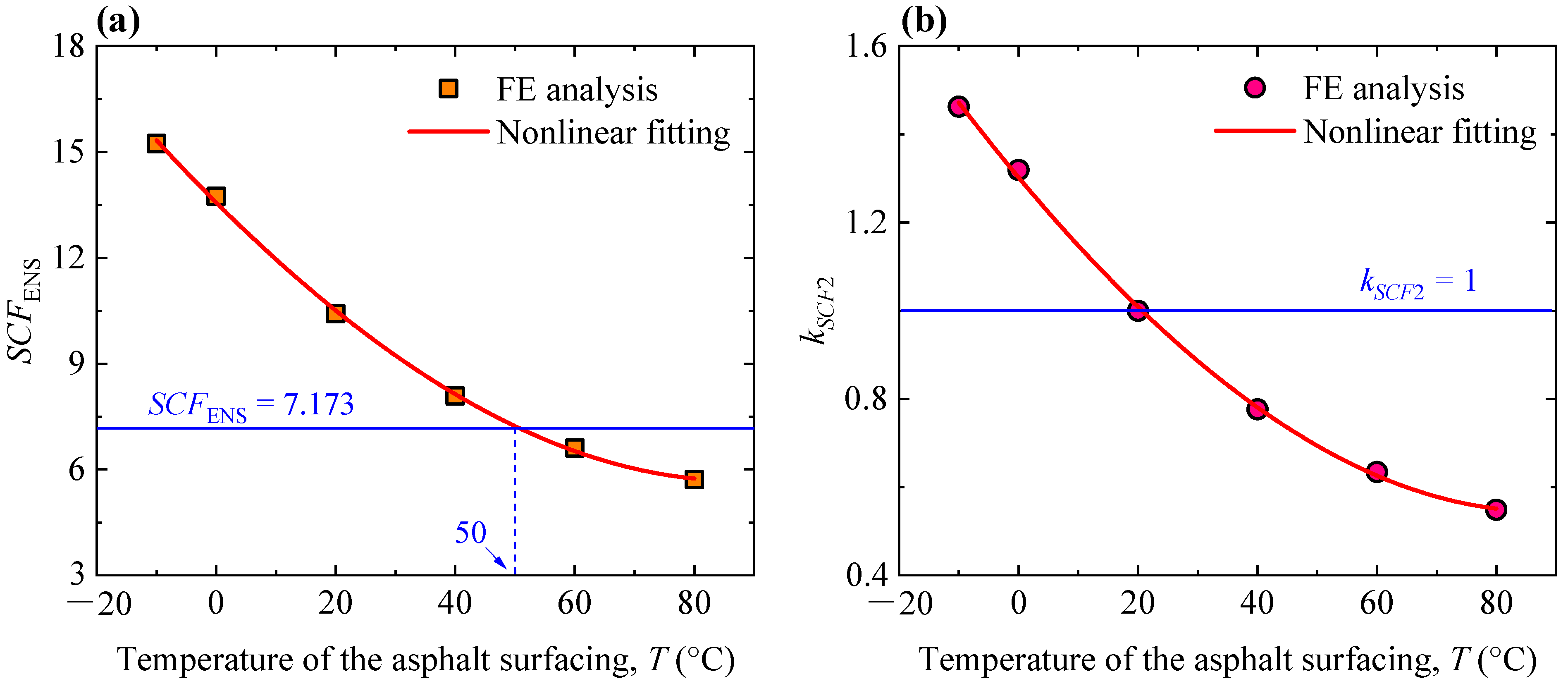
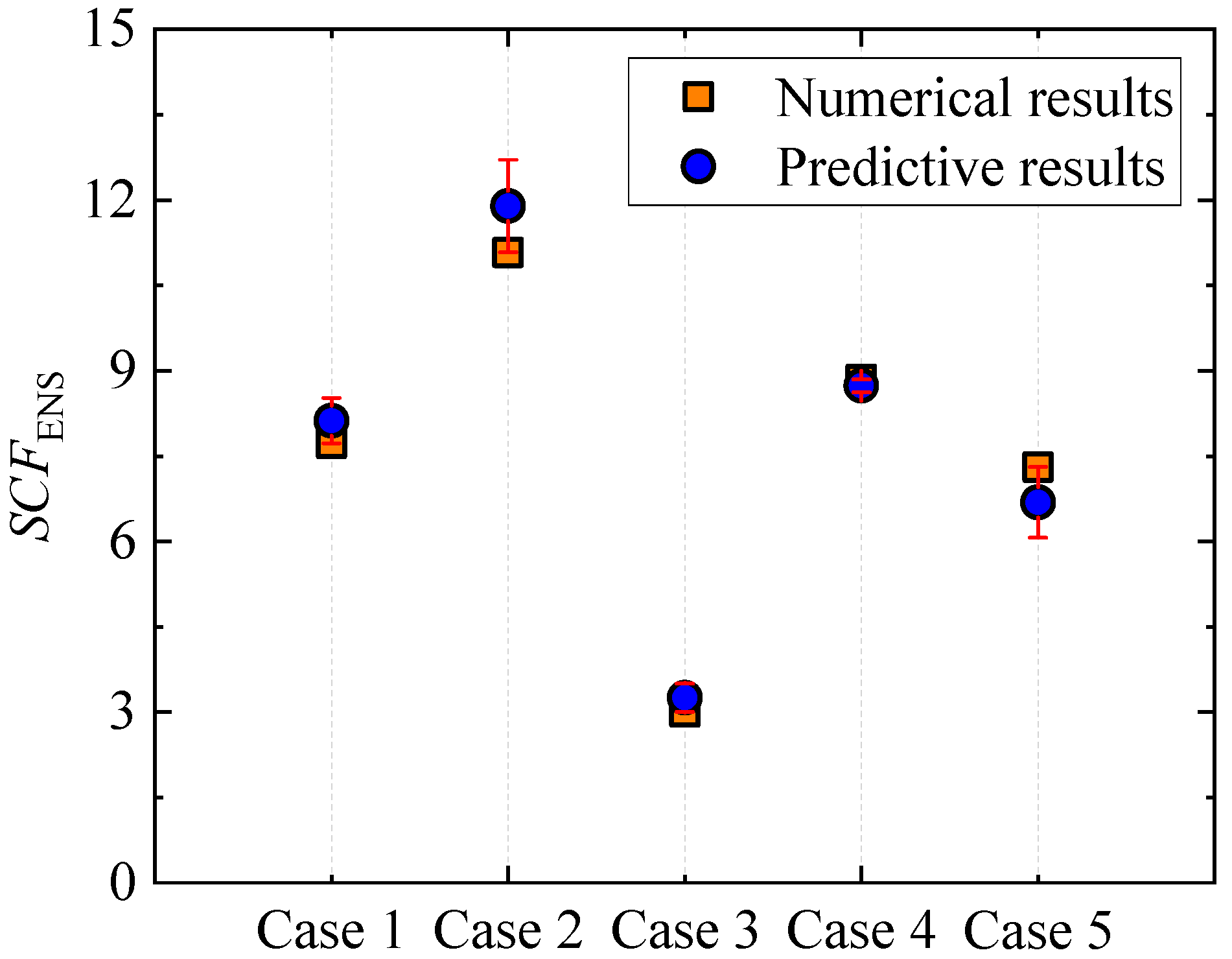
| Case | Transverse Loading Position (m) | Temperature of the Asphalt Surfacing (℃) |
|---|---|---|
| 1 | x = 0.05 | T = 5 |
| 2 | x = −0.05 | T = 15 |
| 3 | x = 0.15 | T = 25 |
| 4 | x = −0.15 | T = 35 |
| 5 | x = 0 | T = 50 |
| Case | Numerical Results | Predictive Results | Relative Error (%) |
|---|---|---|---|
| 1 | 7.73 | 8.12 | 5.14 |
| 2 | 11.08 | 11.89 | 7.34 |
| 3 | 3.01 | 3.25 | 8.36 |
| 4 | 8.85 | 8.74 | −1.27 |
| 5 | 7.31 | 6.69 | −8.48 |
Disclaimer/Publisher’s Note: The statements, opinions and data contained in all publications are solely those of the individual author(s) and contributor(s) and not of MDPI and/or the editor(s). MDPI and/or the editor(s) disclaim responsibility for any injury to people or property resulting from any ideas, methods, instructions or products referred to in the content. |
© 2023 by the authors. Licensee MDPI, Basel, Switzerland. This article is an open access article distributed under the terms and conditions of the Creative Commons Attribution (CC BY) license (https://creativecommons.org/licenses/by/4.0/).
Share and Cite
Wang, Q.; Shi, S.; Yao, Y.; Wang, Z.; Fu, Z. Effective Notch-Stress-Based Stress Concentration Factors of the Rib–Deck Weld in Orthotropic Steel Decks Considering the Effect of Asphalt Surfacing. Materials 2023, 16, 6760. https://doi.org/10.3390/ma16206760
Wang Q, Shi S, Yao Y, Wang Z, Fu Z. Effective Notch-Stress-Based Stress Concentration Factors of the Rib–Deck Weld in Orthotropic Steel Decks Considering the Effect of Asphalt Surfacing. Materials. 2023; 16(20):6760. https://doi.org/10.3390/ma16206760
Chicago/Turabian StyleWang, Qiudong, Shanchun Shi, Yue Yao, Zhiqiang Wang, and Zhongqiu Fu. 2023. "Effective Notch-Stress-Based Stress Concentration Factors of the Rib–Deck Weld in Orthotropic Steel Decks Considering the Effect of Asphalt Surfacing" Materials 16, no. 20: 6760. https://doi.org/10.3390/ma16206760
APA StyleWang, Q., Shi, S., Yao, Y., Wang, Z., & Fu, Z. (2023). Effective Notch-Stress-Based Stress Concentration Factors of the Rib–Deck Weld in Orthotropic Steel Decks Considering the Effect of Asphalt Surfacing. Materials, 16(20), 6760. https://doi.org/10.3390/ma16206760






